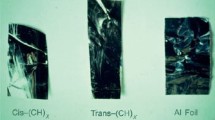Abstract
It is shown that the method for the growth of conducting polyaniline nanotubes, based on the direct polymerization of aniline on the surface of channels in track membranes, can be used to produce nanotubes with a given conductivity. An island-type film with a channel resistance of ~1019 Ω is formed during the initial stage of polymerization (up to 2 min). As the polymerization duration increases to 3 min, the channel resistance falls by more than 10 orders of magnitude. This is attributed to the formation of a continuous film on the channel surface, i.e., a nanotube is formed. With the polymerization duration increasing further, the channel (nanotube) resistance gradually decreases to ~1019 Ω at 10 min. The conductivity of polyaniline during the formation of a hollow nanotube is estimated to be 0.01–0.04 S/cm. If the nanotube is completely filled with polyaniline, the conductivity increases to ~0.2 S/cm.
Similar content being viewed by others
References
A. N. Aleshin, Adv. Mater. 18, 17 (2006).
J. Huang, Pure Appl. Chem. 78, 15 (2006).
S. R. Sivakkumar, W. J. Kim, J. A. Choi, D. R. Mac Farlane, M. Forsyth, and D. W. Kim, J. Power Sources 171, 1062 (2007).
A. Z. Sadek, W. Wlodarski, K. Kalantar-Zadeh, C. Baker, and R. B. Kaner, Sens. Actuators, A 139, 53 (2007).
M. Y. Chang, C. S. Wu, Y. F. Chen, B. Z. Hsieh, W. Y. Huang, K. S. Ho, and Y. K. Han, Org. Electron. 9, 1136 (2008).
C. O. Baker, Xinwei Huang, W. Nelson, and R. B. Kaner, Chem. Soc. Rev. 46, 1510 (2017).
M. Delvaux, J. Duchet, P. Y. Stavaux, R. Legras, and S. Demoustier-Champagne, Synt. Met. 113, 275 (2000).
J. Stejskal, I. Sapurina, J. Prokeš, and J. Zemek, Synt. Met. 105, 195 (1999).
I. Sapurina, A. Riede, and J. Stejskal, Synt. Met. 123, 503 (2001).
M. A. Shishov, V. A. Moshnikov, and I. Yu. Sapurina, Russ. J. Appl. Chem. 86, 51 (2013).
I. Yu. Sapurina, Extended Abstract of Doctoral Dissertation (Inst. Macromol. Compds. RAS, St. Petersburg, 2015).
M. Schnippering, H. V. Powell, S. R. Mackenzie, and P. R. Unwin, J. Phys. Chem. C 113, 20221 (2009).
B. I. Shklovskii and A. L. Efros, Electronic Properties of Doped Semiconductors (Nauka, Moscow, 1979; Springer, New York, 1984), Chap. 5.
Author information
Authors and Affiliations
Corresponding author
Additional information
Original Russian Text © V.M. Kapralova, I.Yu. Sapurina, N.T. Sudar’, 2018, published in Fizika i Tekhnika Poluprovodnikov, 2018, Vol. 52, No. 6, pp. 671–674.
Rights and permissions
About this article
Cite this article
Kapralova, V.M., Sapurina, I.Y. & Sudar’, N.T. Variation in the Conductivity of Polyaniline Nanotubes During Their Formation. Semiconductors 52, 816–819 (2018). https://doi.org/10.1134/S1063782618060076
Received:
Accepted:
Published:
Issue Date:
DOI: https://doi.org/10.1134/S1063782618060076



